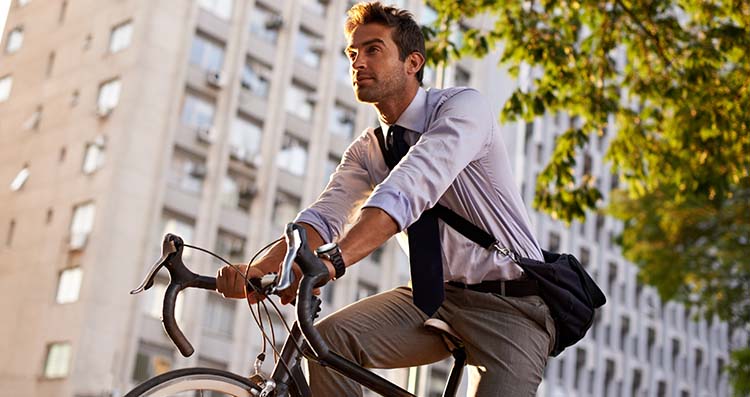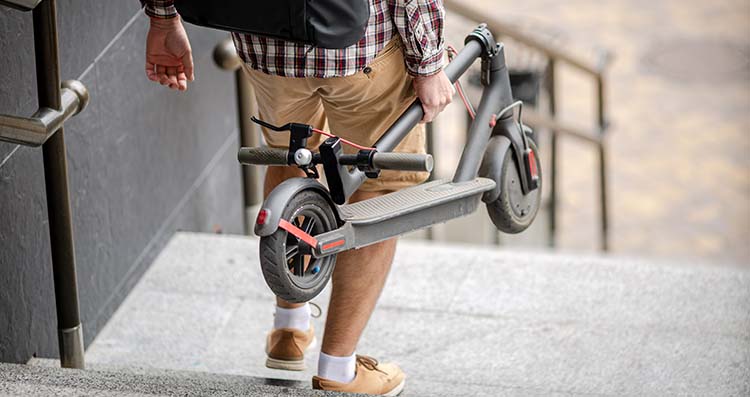Safe commuting by bike: what is your responsibility as an employer?
It’s becoming increasingly popular to bike to and from work. As an employer, it’s not always easy to guarantee the safety of employees. After all, much depends on how responsible they are while cycling and following traffic rules. But there are still things you can do to help your employees hit the road on their bikes as safely as possible.

Good for health and the environment
The growing popularity of cycling is not surprising. After all, cycling does wonders for both physical and mental health. It also has a positive effect on absenteeism, making it an essential part of a sustainability policy. So, pedalling to and during work provides numerous benefits to employees and employers alike. But where does your responsibility lie when employees take to their bikes?
To and from work
Employees who are not on company grounds outside of working hours do not fall under the responsibility of an hierarchical superior. After all, the employer has little to no influence on traffic situations, so employees are personally responsible for taking all necessary precautions to prevent an accident. Nevertheless, it’s always a good idea to build greater awareness among employees about safe cycling behaviour.
Keep in mind, however, that if employees lease their bikes through work, you are responsible for maintenance and providing the necessary protective gear.

During working hours
Do your employees use a bike at work? If so, this means of transport is considered work equipment. This also applies if you allow employees to use their own bike for work-related travel. After all, they are cycling during working hours. This means that you need to take the necessary measures to avoid risks. The following are the three most important ones:
- Take responsibility for maintenance
In 2023, as many as 1.62% of Belgian employees rode leased company bikes. Add to that the number of cyclists who use their own bike and the total is quite high. Want to guarantee the safety of these road users? The best place to start is with bicycle maintenance. As an employer, you are required to carry out the necessary inspections and ensure that employees are able to safely use their two-wheelers at all times.
Every organisation decides for itself how often, where and which qualified professional carries out maintenance and must document this in an internal procedure. - Provide bicycle helmets and other safety equipment
In Belgium, 68% of cyclists never wear a bicycle helmet. Only the Netherlands and Hungary score worse. A bicycle helmet is not compulsory, but in the event of an incident, it can mean the difference between life and death. According to the Belgian road safety institute Vias, a helmet reduces the risk of serious head injury by 60% in the event of an accident. So, why not make sure that your employees have a bicycle helmet available?
A bicycle helmet is also 120% tax deductible. This also applies to other safety equipment, such as high-visibility vests, reflectors and bicycle lights. In addition to fall protection, attention to sufficient visibility in traffic is essential for safe commuting.
- Offer training courses
Employees are increasingly interested in electric bicycles because they are faster and therefore save them time. Speed pedelecs, for instance, can reach speeds of up 45 km/h. But in the event of an accident, injuries are often more serious than with traditional bikes. Moreover, research shows that bicycle accidents are often the result of the cyclist’s own behaviour.
This makes it a good idea to reserve part of your budget for training, so that your employees are well prepared to hit the road on their lease bike (electric or otherwise). The Flemish Foundation for Traffic Knowledge (VSV) organises training courses for companies to make cyclists aware of the road code and safe cycling. A specific training course for speed pedelec users was also introduced a few years ago.

What about electric steps?
According to law, an electric step is not a means of transport, but a ‘personal mobility device’. This means that different rules apply.
For example, an employer is not required to pay a bicycle allowance if employees commute to work on a step. All the same, it’s advisable to provide the necessary protective gear and training for these as well. A helmet may not be required, but it can reduce the seriousness of an injury in the case of a fall. Also, visibility and traffic safety go hand in hand, so high-visibility clothing can make an important difference.
To help prevent accidents, Vias has put together a list of 10 recommendations for step users.
Commit to safe commuting
You can trust our experts to develop an effective health and safety policy that focuses on deploying healthy employees in the safest possible way. Looking for more ideas, inspiration or advice to keep your employees healthy? Subscribe to our newsletter.